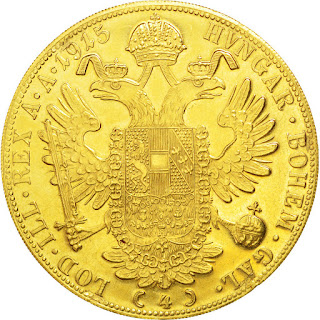Austrian Gold Coins 4 Ducats 1915 Emperor Franz Joseph I of Austria, King of Bohemia and Apostolic King of Hungary
Restrikes - The first thing to note about the Austrian 4 Ducat coin of 1915, is that it was not minted in 1915!
Obverse: Laureated head of Francis Joseph I facing right
Legend around: FRANC·IOS·I·D·G·AVSTRIAE IMPERATOR. Translation: Francis Joseph I by Grace of God Austrian Emperor.
Reverse: Imperial-Royal coat of arms of the Austrian Empire from 1804: the double-headed eagle with marshaled arms of Habsburg, Babenberg and Lorraine displayed on the Escutcheon, Order of the Golden Fleece and Imperial Crown. Legend around (starts 1h) for "Hungariae Bohemiae Galiciae Lodomeriae Illyriae Rex Archidux Austriae" - (Hungary, Bohemia, Lombardy, Venice, Dalmatia, Galicia, Lodomeria, Illyria, and Archduke of Austria).
Lettering: HVNGAR·BOHEM·GAL· LOD·ILL·REX A·A·1915 ( 4 )
Face value: 4 Dukaten.
Metal: Gold (.986).
Weight: 13.9636 g.
Diameter: 40 mm.
Struck by the Austrian Mint.
The 4 Ducats gold coins are manufactured from gold of 98.60% fineness, the equivalent of 23 ¾ carats, a very good quality for a gold coin that used to be issued for circulation. These Austrian gold coins are only 0.7 mms thick, which is little compared with modern coins. This is due to the fact that they inherit the aspect of medieval gold coins. Their gold content weighs 13.76 grams or 0.4430 troy ounces of gold.
The modern restrikes
From 1920 until 1936 the First Austrian Republic minted 1 and 4 ducat coins with the old 1915 dies. At the beginning of the 1950’s the Second Republic added the golden and the corona to the range of gold restrikes, each with the date of their last official mintage. These imperial restrikes are very popular as gifts and as a means of hoarding gold. They are the traditional gold coins of Austria, and are known and traded beyond the borders of modern Austria and even in the markets of overseas continents. The coins are sold at a small premium over their actual gold value. Banks and dealers quote buy and sell prices based on the daily price of gold.

